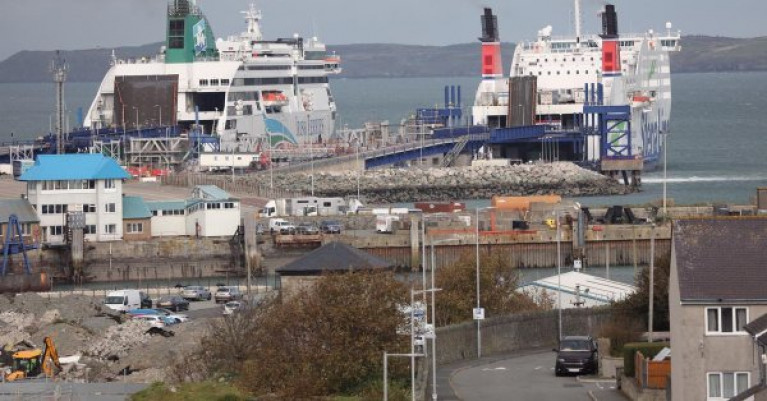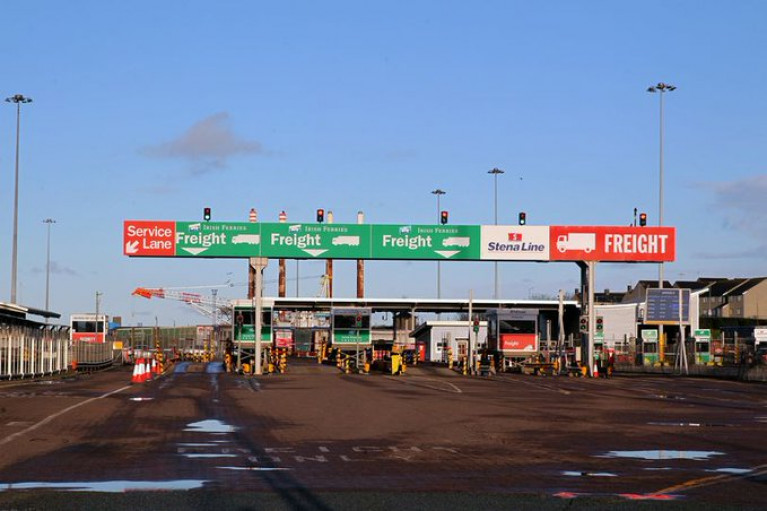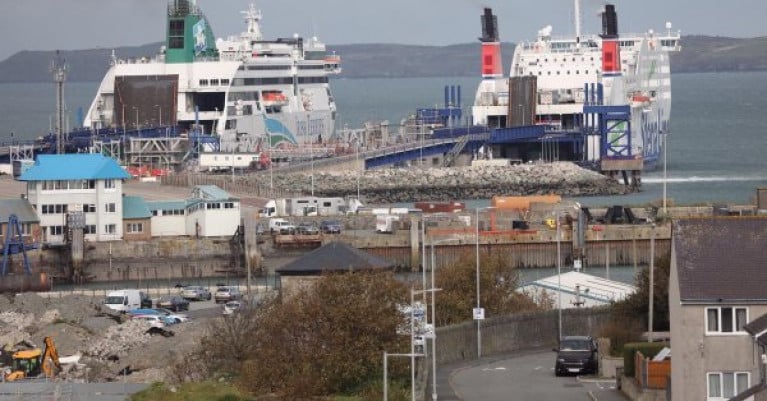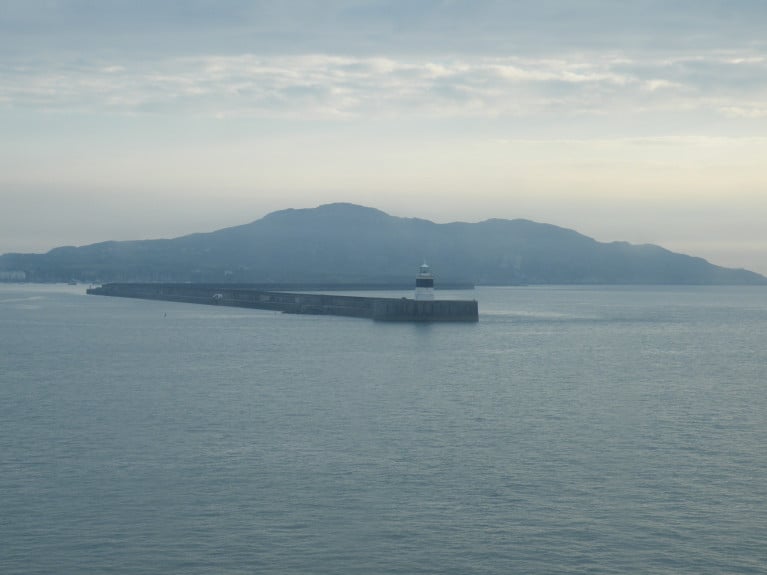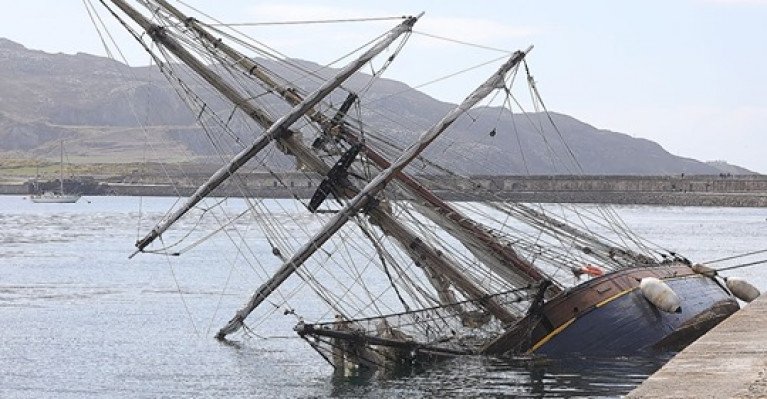Displaying items by tag: Holyhead
Royal Holyhead Yacht Club To Be Born Again
When the Irish Sea Offshore Racing Association (ISORA) was in its rapid expansion stage in the 1970s, one of its most active clubs was Holyhead SC, the sea-going base for many from Merseyside, including leading Liverpool medics and Irish Sea offshore racing fanatics Dickie Richardson and Alan Stead.
Yet although at any ISORA conference, the two “demon doctors” could bring to the negotiation table their personal memberships of the Royal Mersey at Birkenhead across the river from Liverpool (founded in 1844) and the even older Royal Dee YC in Cheshire (founded 1815), they felt frustrated.
 The late Dickie Richardson in 1972, when he was founding Chairman of the Irish Sea Offshore Racing Association, having co-ordinated its emergence from the Northwest Offshore Association.
The late Dickie Richardson in 1972, when he was founding Chairman of the Irish Sea Offshore Racing Association, having co-ordinated its emergence from the Northwest Offshore Association.
AT A ROYAL DISADVANTAGE
For in dealing with the Irish royal yacht clubs, and the Royal Ocean Racing Club, they felt like second-division sailing men through the fact that although a Royal Holyhead Yacht Club had been founded in 1854 and acquired the royal warrant in 1858, it had somehow expired within twenty years. Thus they’d to fight their corner as the ordinary Holyhead Sailing Club, founded originally in 1905 as the Porth-y-Felin SC.
ORIGINAL ROYAL HOLYHEAD “JUST FADED AWAY”
Admittedly when back in Merseyside, both Richardson and Stead personally felt most at home at the notably friendly Tranmere Sailing Club. But they had no doubt that an ancient Royal warrant for Holyhead would be a useful negotiating aid in pushing support for their offshore programme development, and the improvement of Holyhead sailing generally. Yet when they and various officials looked into the idea in depth, it was found that all official documents crucial to the foundation and royal warrant of the Royal Holyhead Yacht Club seemed to have long since disappeared, with no at all mention of the club after 1875.
 With its majestic new extra-long breakwater, it had been hoped in the mid-19th Century that Holyhead could support a royal yacht club
With its majestic new extra-long breakwater, it had been hoped in the mid-19th Century that Holyhead could support a royal yacht club
As it happens, the proliferation of Royal yacht clubs in the Merseyside/North Wales area in the 19th Century was remarkable, reflecting the fact that the mighty trading and passenger port city of Liverpool was, for two or three decades, the richest per capita city in the world. The Royal Welsh YC – now charmingly housed in rooms within the walls of Caernarvon Castle – came into being in 1847. But perhaps more crucially for any continuing life of the Royal Holyhead, the Royal Anglesey at Beaumaris on the more picturesque side of Anglesey set up shop in 1885, while claiming its earliest known origins went way back to 1802.
EXTRA-LONG BREAKWATER
Thus although Holyhead with its handsome new extra-long breakwater (1.7 miles long and built from 1848 onwards) seemed to have features in common with what was then Kingstown across in Ireland, Kingstown faced northeast from a sheltered weather shore, whereas the small and otherwise remote town of Holyhead faced west, exposed to the prevailing winds.
 The Royal Anglesey Yacht Club’s Fife Class ODs racing off Beaumaris on the sheltered side of Anglesey against the impressive backdrop of Snowdonia. Photo: Ian Bradley
The Royal Anglesey Yacht Club’s Fife Class ODs racing off Beaumaris on the sheltered side of Anglesey against the impressive backdrop of Snowdonia. Photo: Ian Bradley
Even the fact that Holyhead’s location was sometimes used as a sort of mid-point venue to stage match races between each season’s hottest new boats from the Clyde and the Solent wasn’t enough to give the place a gloss of glamour. It took the more egalitarian outlook of the early 20th Century to find that what had come to be seen as a very utilitarian ferry port and harbour of refuge really did have potential as a recreational sailing centre. But at the time no-one thought of reviving the old Royal Holyhead, as it was assumed that all aspirations for such clubs were locally met by the Royal Anglesey and the Royal Welsh.
 Today’s Holyhead Sailing Club has evolved from the Porth-y-Felin SC, founded in 1905
Today’s Holyhead Sailing Club has evolved from the Porth-y-Felin SC, founded in 1905
 Holyhead in northwest Anglesey, Beaumaris on southeast coast
Holyhead in northwest Anglesey, Beaumaris on southeast coast
Yet since then, there have always been devotees – names not revealed for now - who felt that Holyhead sailing deserved the revival of its royal status, somewhat heatedly making the point that when they sailed across to supposedly republican Dun Laoghaire, they find themselves welcomed into the Royal Irish or the Royal St George Yacht Clubs, they know that the Royal Alfred YC is still somewhere quietly ticking away, and if they are driven into Dublin, they find themselves going past the premises of the Royal Dublin Society and on into stately streets and city squares where you can happen upon the Royal Irish Academy, the Royal College of Surgeons in Ireland, the Royal Hibernian Academy, the Royal Institute of the Architects and Ireland, and enough other similarly august organisations that thrust a sort of republican royalty down the throats of any visitors from towns less royally furnished.
 Cruiser-racing within the breakwater at Holyhead. Although there’s no doubting it’s primarily a ferry port, there’s plenty of room for everyone.
Cruiser-racing within the breakwater at Holyhead. Although there’s no doubting it’s primarily a ferry port, there’s plenty of room for everyone.
HEIGHT OF EXCITEMENT IN RAC SERVICE VAN?
“Back in Holyhead” fumed one, “we have the RNLI and the Royal British Legion, but that’s just not the same. And for sure we have Royal Air Force Valley just up the road, but somehow that doesn’t seem to count in the same way either. In fact, we’re so royalty-depleted that there’s real excitement when the RAC service van drives through the town. So we’ve been working for years behind the scenes and in various document searches to see if we can revive the Royal Holyhead Yacht Club just like your Royal Western of Ireland YC was revived across in Kilrush”.
A noble aspiration. And finally, there’s good news. The restoration of a very old semi-derelict house in an un-named location in North Wales has revealed a cache of documents which may validate the existence of the Royal Holyhead Yacht Club. It’s early days yet, but fifty years have passed since Dickie Richardson and Alan Stead first aired the idea. So we can wait a year or two until the stencils for Royal Holyhead YC can be applied to the transom, though the ensigns and burgees are ready for take-off.
At the Port of Holyhead, Cunard Line's cruiseship Queen Victoria sailed into the ferryport at the weekend on its first ever visit to Wales.
The giant Vista class vessel is one of 81 cruiseships scheduled to visit Welsh ports during 2023 and of this total, more than 50 cruiseships are set to arrive at Holyhead which is owned by the ferry operator, Stena Line.
When combined, the cruise ships calling to Wales will generate 80,000 passengers and 39,000 crew, which equates to a potential passenger day spend income of £8.3 million for the Welsh economy.
The revamped jetty in Holyhead Harbour was acquired by ferry operator last year and this has enabled the large Queen Victoria to berth at the former Anglesey Aluminium plant jetty.
Welcoming the visiting tourists was the Deputy Minister for Arts, Sport and Tourism, Dawn Bowden. The cruiseship carries 2,061 passengers and 981 crew, though at 90,049 gross tonnage (GT) this ship is the smallest of the Cunard fleet in operation.
It is carrying passengers from 28 different nationalities on a cruise of the UK and Ireland from where Queen Victoria has visited several ports across the Irish Sea among them Dublin Port.
More from NorthWales Live on the increase of cruiseships calling.
Freeport Status Secured in North Wales in Move Backers Say Will Create Thousands of Jobs
A freeport status in Anglesey, north Wales has been secured in a move backers say will create thousands of jobs for the region.
The Welsh Government in May, 2022 had reached an agreement with the UK Government to establish a freeport programme in Wales. This followed a long stand-off between the governments over the levels of funding.
The island freeport around Holyhead (located on Holy Island off Angelsey), was up against bids from ports in south Wales through Celtic Freeport, comprising of Milford Haven and Port Talbot. In addition to the bid of a multi-site freeport that included Cardiff Airport.
The recent announcement of the Freeports status had confirmed that Anglesey and the Celtic Freeport had both been successful bidders.
The UK and Welsh governments announced the news as a joint decision and this will lead the UK Government to provide up to £26m of non-repayable starter funding for the three freeports.
Of these ports, Afloat highlights Holyhead and Milford Haven (Pembroke Dock) have ferry links to Ireland.
For much more on the freeports deal which has secured £52m, NorthWalesLive reports.
Cunard Head to Holyhead, Anglesey this Summer as Cruise Tourism Becomes 'Big Business' in Wales
Cruisecalls among them from Cunard Line is to visit the Port of Holyhead, Anglesey this summer as the tourism sector booms in Wales.
This year the country is due to welcome a record 91 cruiseships to date, with Holyhead port leading the way with more than half of the total calling to the port.
Across the Irish Sea, as Afloat reported Dun Laoghaire Harbour (alone is to pip the Welsh national total) with 92 cruise visits booked this season so far to visit the Irish harbour, though no 'Cunarders' are scheduled to call this year.
Holyhead, however will have the prestigious MS Queen Victoria which is scheduled to dock on 4 June, its first call at the deep water jetty (acquired, see story) under Stena Line’s ownership. The Vista class 16-deck ship, is likened to a sea liner because of its interior decor, and the Italian built cruiseship (a sister of Queen Elizabeth), is capable of carrying almost 2,100 passengers as well as 900 crew.
The “cruise is big business in Wales” and this is where the Welsh Government has been working with Cruise Wales – a partnership between the country’s six cruise ports. Asides Holyhead, Afloat adds all these ports are all in south Wales, they are Fishguard, Pembroke Dock (Milford Haven), Swansea, Cardiff and Newport.
To promote the sector, Cruise Wales is develop new onshore tour itineraries for passengers and also to showcase the nation’s attractions. Examples of these new breed of itineraries include the themes of ‘Coal, Coin and Cheers’ with tours throughout south Wales.
In total this year Wales is to see 80,000 passengers and 39,000 crew, this equates to a potential passenger day spend income of £8.3 million.
The first call of the 2023 season to Holyhead will be Viking Venus on 6 April and on the same day Spitzbergen is scheduled to visit Fishguard.
Holyhead is to welcome more than half the nation’s total with 53 calls.
The call by Viking Venus is to take place following a visit to Dun Laoghaire Harbour which opens the season for the Irish port and this will involve an anchorage call.
More from NorthWalesLive here.
The New Prince and Princess of Wales Visit Holyhead RNLI in First Visit Since Appointment
Holyhead RNLI volunteers were honoured to welcome Their Royal Highnesses The Prince and Princess of Wales on Tuesday, during a whistle-stop tour that brought them back to the island they once called home.
The Royal couple met lifeboat crew members and shop volunteers in their first visit to Wales since becoming The Prince and Princess of Wales.
Their Royal Highnesses chatted to volunteers, including 21-year-old lifeboat helm Sion Owens, one of the station’s youngest ever helms, and 83-year-old Gill Davies, who has volunteered in the RNLI shop for over 20 years.
Tony Price, Holyhead RNLI Coxswain, said: ‘It was an absolute pleasure to welcome The Prince and Princess of Wales to Holyhead RNLI and a privilege to have met them. They both showed a genuine and passionate interest in the work of the RNLI, from our shop volunteers to the lifeboat crew.
‘They spent a long time chatting to many of us about our individual roles and the part we play in saving lives at sea. They seemed so at ease and asked many interesting questions about the RNLI, showing a particular interest in mental health.’
 Their Royal Highnesses The Prince and Princess of Wales meet a youngster at Holyhead RNLI
Their Royal Highnesses The Prince and Princess of Wales meet a youngster at Holyhead RNLI
The station has special relevance for The Prince and Princess, as they lived on Anglesey for several years while Prince William was an RAF search and rescue helicopter pilot, stationed at RAF Valley, which included working with the island’s lifeboat crew on rescues during his time in the role.
The Prince and Princess of Wales’ first Royal visit after announcing their engagement was also on the island as they attended a service of dedication for RNLI lifeboat, the Hereford Endeavour, at Trearddur Bay Lifeboat Station in 2013.
The Royal couple had a tour of Holyhead Lifeboat Station, including the ‘local knowledge’ room, put together by the crew for visitors to familiarise themselves with local waters. Their Royal Highnesses were also able to have a close-up view of the station’s D class inshore lifeboat Mary and Archie Hooper.
Holyhead Lifeboat Operations Manager David Owens said: ‘We are extremely honoured that our station was chosen for the couple’s first visit to Wales since becoming The Prince and Princess of Wales.
‘The local people have a genuine fondness for the Royal couple, who were a part of island life while they lived locally. The fact that they have chosen to come to our station indicates how special Anglesey is to them, and how at home they feel here.
‘Our volunteers are very proud of what they do, and meeting The Prince and Princess was a real honour, and something none of them will forget.’
Prince William’s last engagement with the RNLI was at an Emergency Services Day event last year when he met 12-year-old Ravi Saini who made national headlines in 2020 when he used the RNLI’s Float to Live advice after being caught in a rip current while on holiday in Scarborough.
Port of Holyhead Repair Plans for Breakwater After Storm Damage & Vandalism to Go Before Councillors
In North Wales, plans for the "refurbishment and repair" of the Anglesea ferry port landmark battered by storms and damaged by vandals are set to go before planners.
Councillors in Anglesey will consider the proposals for maintenance at Holyhead's historic breakwater and port area.
A full application for the "refurbishment and repair" of the Victorian breakwater structure and the manufacture of concrete at the Salt Island (ferry terminal) site has been received. Holyhead's breakwater provides coastal protection for the port and a number of waterfront facilities in Holyhead New Harbour.
Salt Island is a natural shelter for the town's Old Harbour from the Irish Sea and part of the Port of Holyhead. The latest maintenance plans include the formation of a "temporary concrete batching plant" for the "fabrication, curing and storage of concrete armour units" at Salt Island, and has been received for consideration by Anglesey County Council.
Further coverage NorthWales reports on the port which is operated by Stena Line Ports Ltd.
Holyhead as Welsh towns go has had to reckon with more upheaval than most.
The largest town on the Isle of Anglesey is home to just over 10,000 people but is also one of the UK's largest commercial and ferry ports with millions of heavy goods vehicles, trucks, and tourists passing through every year.
The success of the port, which has existed in some form since 1821, is worth millions of pounds and supplies hundreds of jobs in a region which has seen deprivation levels rise. But one year on from Brexit traffic figures are worrying.
Stena Line has said trade is down 30% at its Welsh ports, which it owns and operates. In December 2020 traders and business figures in Holyhead spoke about the chaos as the hours ticked away until the UK officially left the EU.
Wales On Line has more on the startling impact of 'taking back control' on the port at the frontline of Brexit in Wales
One year on much seems still unclear. The UK is embroiled in fraught negotiations over post-Brexit arrangements for Northern Ireland while the ongoing coronavirus pandemic has made the impact of Brexit on Holyhead difficult to measure.
Further coverage of the story here focusing on the impact on the port town's community.
Passengers 'Scared' as Storm Barra Stops Ferries Berthing in Holyhead for More than 14 Hours
For more than 14 hours, two ferries have been stuck off Holyhead as Storm Barra prevented them from docking at the port, as NorthWalesLive reported last night.
The Stena Adventurer and the Ulysses, which is operated by Irish Ferries, sailed from Dublin to Holyhead but were unable to dock on Wednesday due to the weather conditions.
Passengers described the situation on board as some said they felt "scared" and seasick.
For more click here to include passengers from both of the ferries, that had during the sailings posted updates from their twitter accounts.
Plans to refurbish the Port of Holyhead's Breakwater amid concerns it could fail within the next 15 years has led to a consultation launched.
Investigations of the structure have identified a need for a large scale refurbishment of the Breakwater to ensure that it can continue to receive about 70% of all ferry vehicle movement between Ireland and Wales and the North West.
Since its completion in 1873, the Breakwater has been subject to considerable wave action, which has led to the movement and erosion (as Afloat reported) of the rubble mound, that supports the structures wall.
Over the coming years it is anticipated that the level of the mound will become so low that the footing of the vertical walls will be at risk of being undermined.
"Investigations of the structure have predicted that the Breakwater could fail within the next 15 years meaning a permanent solution must be found," a Stena Line Ports spokesperson said.
More from North Wales Pioneer here.
Stricken Tallship: 'Strong Chance & Hope' Historic Vessel At Holyhead Can Still be Saved
A historic tall ship which ran aground on the Port of Holyhead's breakwater, according to NorthWalesLive, could still be saved as hopes have been raised.
The 83-year-old tall ship Zebu got into difficulties on May 15 and the ship had to be abandoned, after she was grounded on the sea wall.
There were fears the vessel, which was left at a 45 degree angle, may have to be dismantled, with the masts removed earlier this week as bad weather approached.
But inspections by divers have now shown the vessel is not as damaged as previously feared.
A full statement has been put out by the marketing director, for the two-masted clipper, which said there is "a strong chance & hope from Team Zebu that she will be saved."
An investigation also found the cause of the incident was due to the anchor dragging.
For further coverage of the tallship that was bound for Bristol, click here.

